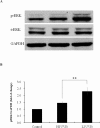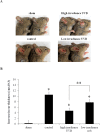Irradiance-dependent UVB Photocarcinogenesis
- PMID: 27869214
- PMCID: PMC5116611
- DOI: 10.1038/srep37403
Irradiance-dependent UVB Photocarcinogenesis
Abstract
Ultraviolet B (UVB) radiation from the sun may lead to photocarcinogenesis of the skin. Sunscreens were used to protect the skin by reducing UVB irradiance, but sunscreen use did not reduce sunburn episodes. It was shown that UVB-induced erythema depends on surface exposure but not irradiance of UVB. We previously showed that irradiance plays a critical role in UVB-induced cell differentiation. This study investigated the impact of irradiance on UVB-induced photocarcinogenesis. For hairless mice receiving equivalent exposure of UVB radiation, the low irradiance (LI) UVB treated mice showed more rapid tumor development, larger tumor burden, and more keratinocytes harboring mutant p53 in the epidermis as compared to their high irradiance (HI) UVB treated counterpart. Mechanistically, using cell models, we demonstrated that LI UVB radiation allowed more keratinocytes harboring DNA damages to enter cell cycle via ERK-related signaling as compared to its HI UVB counterpart. These results indicated that at equivalent exposure, UVB radiation at LI has higher photocarcinogenic potential as compared to its HI counterpart. Since erythema is the observed sunburn at moderate doses and use of sunscreen was not found to associate with reduced sunburn episodes, the biological significance of sunburn with or without sunscreen use warrants further investigation.
Figures




References
-
- Matsumura Y. & Ananthaswamy H. N. Toxic effects of ultraviolet radiation on the skin. Toxicol Appl Pharmacol 195, 298–308 (2004). - PubMed
-
- IARC Working Group. IARC Handbooks of cancer prevention. Vol. 5 (eds International Agency for Research on Cancer) Ch.5, Cancer-preventive effects of sunscreens. Pp69–124, (Lyon, France, 2001).
-
- Marrot L. & Meunier J. R. Skin DNA photodamage and its biological consequences. J Am Acad Dermatol 58, S139–148 (2008). - PubMed
-
- Christensen D. Data still cloudy on association between sunscreen use and melanoma risk. J Natl Cancer Inst 95, 932–933 (2003). - PubMed
-
- Ghiasvand R., Lund E., Edvardsen K., Weiderpass E. & Veierod M. B. Prevalence and trends of sunscreen use and sunburn among Norwegian women. Br J Dermatol 172, 475–483 (2015). - PubMed
Publication types
MeSH terms
Substances
LinkOut - more resources
Full Text Sources
Other Literature Sources
Research Materials
Miscellaneous

